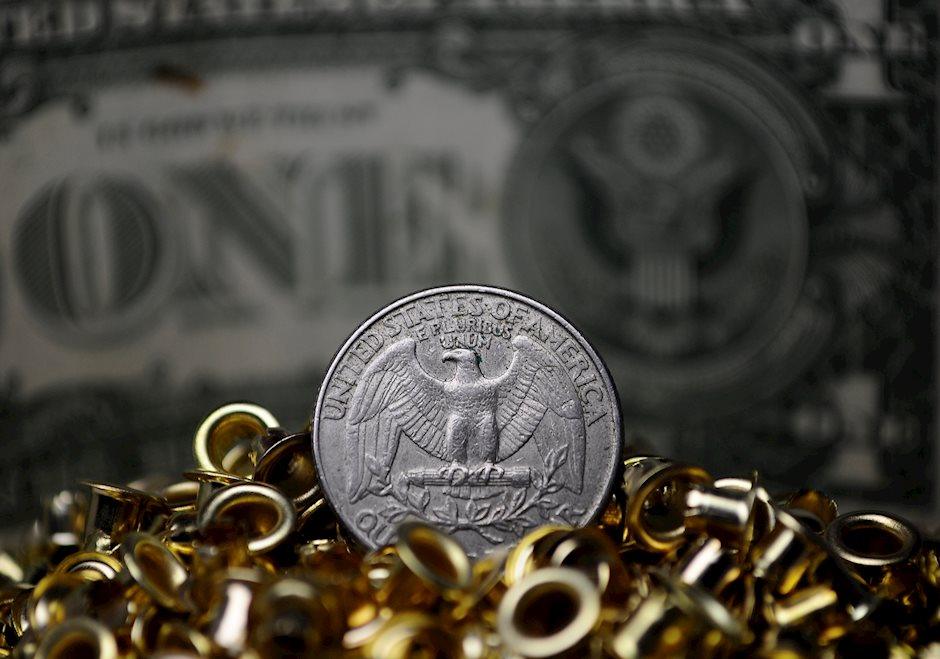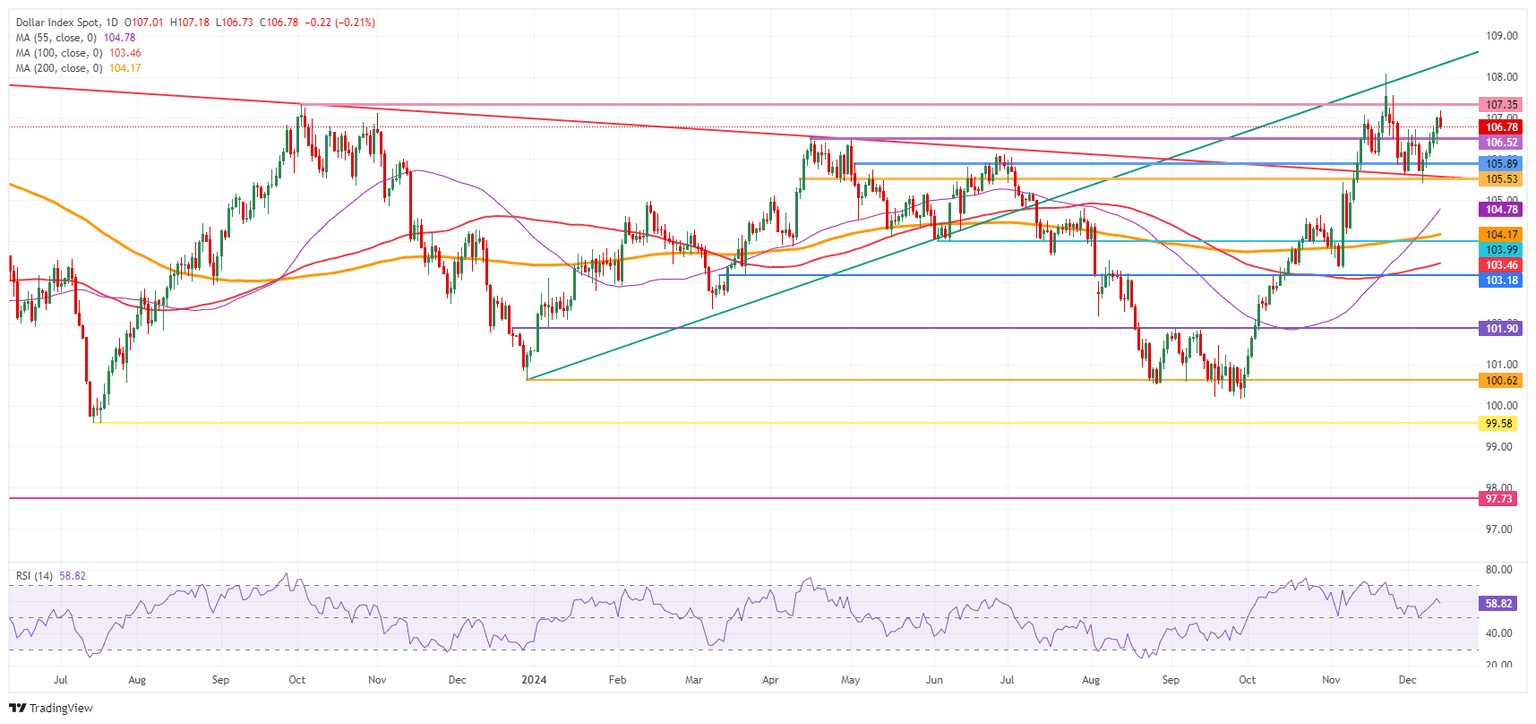US Dollar goes nowhere on Friday after another stellar performance throughout the week
- The US Dollar turns flat and sees earlier gains evaporate ahead of US trading session on Friday.
- The Greenback faces some downside pressure due to some profit taking after its steep rally earlier this week.
- The US Dollar Index (DXY) trades below 107.00 under pressure from some profit taking.

The US Dollar (USD) is facing some pressure on Friday from traders reducing their positions in the Greenback in the US trading session. Some profit taking is happening just before the weekend after the Greenback received some inflow on the back of a weaker Euro and a weaker Yuan. The release of the Import and Export data this Friday did not really help with all numbers falling roughly flat.
The USD got a boost on Thursday after Producer Price Index (PPI) data for November came well above expectations. While the data failed to change the broader view that the US Federal Reserve (Fed) will cut interest rates by 25 basis points next week, it did pare some bets of further cuts in 2025.
The Greenback was also supported by expectations of further stimulus elsewhere. In Europe, the European Central Bank (ECB) President Christine Lagarde admitted that a 50 basis point rate cut scenario was on the table. However, the Governing Council agreed that a 25 basis point rate cut was more appropriate.
In China, recent news also signaled bolder economic support in 2025. The Politburo, led by President Xi Jinping, vowed to embrace a “moderately loose” monetary policy in 2025 and a “more proactive” fiscal policy. In response, bond prices have soared and China’s 10-year bond yields fell to a record low of 1.77%, Bloomberg reports.
Daily digest market movers: Fed in focus next week
- China's top leaders and policymakers are considering allowing the yuan to weaken in 2025, Reuters reports. Several analysts are seeing the risk that China is heading towards a Japan scenario, where bond yields could fall further, Bloomberg reports.
- The Import-Export Price Index for November did not really move the neeedle. The monthly Export Index fell to 0% after expanding in October by 1%. The Import Index remained at 0.1%, similar as in October.
- Equities are very geographically divided this Friday. In Asia, all major Chinese and Japanese indices are in red territory. Meanwhile, in Europe and in the US, the major indices are seeing green numbers.
- The CME FedWatch Tool is pricing in another 25 basis points (bps) rate cut by the Fed at the December 18 meeting by 96.4%.
- The US 10-year benchmark rate trades at 4.35%, a fresh high for this week.
US Dollar Index Technical Analysis: Elevated positioning for next week
The US Dollar Index (DXY) is being fueled for another rally thanks to the move in bond markets this week. After the ECB already widened the rate differential gap between the US and Europe, prospects of further easing in China add to that gapthis Friday China is adding to that gap. WiIth the plunge in Chinese yields, the gap between the US and China is getting wider, fueling which fuels a stronger US Dollar.
The 107.00 got broken this Friday, but and needs to see a daily close above it, to actbe acting as support from; now on. Very close, by there is the 107.35 (October 3, 2023, high) level that might act as a brief resistance. Further up, the high of November 22 at 108.7 emerges.
Looking down, 106.52 is now the new first supportive level to look for in case ofif any profit taking should occur. Next in line is the pivotal level at 105.53 (April 11 high) that comes into play before heading into the 104-region. Should the DXY fall all the way towards 104.00, the 200-day Simple Moving Average at 104.17 should catch any falling knife formation.
US Dollar Index: Daily Chart
Central banks FAQs
Central Banks have a key mandate which is making sure that there is price stability in a country or region. Economies are constantly facing inflation or deflation when prices for certain goods and services are fluctuating. Constant rising prices for the same goods means inflation, constant lowered prices for the same goods means deflation. It is the task of the central bank to keep the demand in line by tweaking its policy rate. For the biggest central banks like the US Federal Reserve (Fed), the European Central Bank (ECB) or the Bank of England (BoE), the mandate is to keep inflation close to 2%.
A central bank has one important tool at its disposal to get inflation higher or lower, and that is by tweaking its benchmark policy rate, commonly known as interest rate. On pre-communicated moments, the central bank will issue a statement with its policy rate and provide additional reasoning on why it is either remaining or changing (cutting or hiking) it. Local banks will adjust their savings and lending rates accordingly, which in turn will make it either harder or easier for people to earn on their savings or for companies to take out loans and make investments in their businesses. When the central bank hikes interest rates substantially, this is called monetary tightening. When it is cutting its benchmark rate, it is called monetary easing.
A central bank is often politically independent. Members of the central bank policy board are passing through a series of panels and hearings before being appointed to a policy board seat. Each member in that board often has a certain conviction on how the central bank should control inflation and the subsequent monetary policy. Members that want a very loose monetary policy, with low rates and cheap lending, to boost the economy substantially while being content to see inflation slightly above 2%, are called ‘doves’. Members that rather want to see higher rates to reward savings and want to keep a lit on inflation at all time are called ‘hawks’ and will not rest until inflation is at or just below 2%.
Normally, there is a chairman or president who leads each meeting, needs to create a consensus between the hawks or doves and has his or her final say when it would come down to a vote split to avoid a 50-50 tie on whether the current policy should be adjusted. The chairman will deliver speeches which often can be followed live, where the current monetary stance and outlook is being communicated. A central bank will try to push forward its monetary policy without triggering violent swings in rates, equities, or its currency. All members of the central bank will channel their stance toward the markets in advance of a policy meeting event. A few days before a policy meeting takes place until the new policy has been communicated, members are forbidden to talk publicly. This is called the blackout period.
Author

Filip Lagaart
FXStreet
Filip Lagaart is a former sales/trader with over 15 years of financial markets expertise under its belt.


















